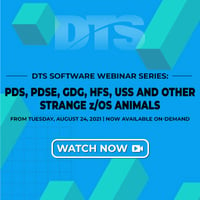Unlike Partitioned data sets, which are useful if you have a bunch of different types of data that you want to keep all in a single data set, or VSAM data sets, which are useful for more sophisticated types of access by key or by relative record, sequential data sets are the simplest form of data set. Not surprisingly, they’re useful if you want to read the data in sequence, and when we specify the data set organization in the JCL or define the data set under ISPF, we specify a data set organization or DSORG equal to PS (or occasionally, PSU, or DA).
Sequential data sets can be one of three types, BASIC, LARGE, or Extended Format. If you don’t specify anything out of the ordinary, you get a Basic format data set, which is simply a collection of extents on a disk that is being pointed to by the Volume Table of Contents (VTOC) and the VSAM Volume Data Set (VVDS). Because it’s ordinary sequential data, you can use the Queued or Basic Sequential Access Methods (QSAM or BSAM) to write to it, but it has to be written sequentially — before you write record two, you must write record one.
Sequential data sets are original to z/OS (or MVS, back in the 60s), and thus have some limitations. Basic data sets can have no more than 16 extents per volume and a maximum of 65,535 tracks total even if the data set goes to more than one volume. If you need to exceed that number, you can create a large sequential data set by specifying the DSNTYPE=LARGE parameter. A large format dataset is still limited to 16 extents per volume, but you can have 16,777,215 tracks per volume.
Because the limit of 16 extents is somewhat restrictive, you can use an extended-format sequential data set. Extended-format datasets are implicitly LARGE and can exceed 65,535 tracks, but more importantly, you can get up to 123 extents per volume, offering a few clear advantages. For one, an extended-format data set allows you to fail with anOut-Of-Space error much less often, but it can also be striped. With a single stripe, it’s just an ordinary sequential data set, but if it’s multi-striped, each volume can be read and written in parallel. For an application such as SMF data, where there’s a large amount of sequential data, it’s useful to stripe the data across multiple volumes so they can be read much more quickly.
Wealth of z/OS Webinar Training on DTSSoftware.com
 This is a simple breakdown of sequential data sets, but DTS Software has a wealth of additional information on partitioned datasets, PDEs, generation data groups, hierarchical file structures, and UNIX services on z/OS. To learn more, click here to view our August 2021 webinar on demand: “PDS, PDSE, GDG, HFS, USS and Other Strange z/OS Animals.” In this presentation, DTS Software CTO Steve Pryor takes a deep dive into the peculiarities of storage elements on z/OS to help you make sense of these often confounding creatures.
This is a simple breakdown of sequential data sets, but DTS Software has a wealth of additional information on partitioned datasets, PDEs, generation data groups, hierarchical file structures, and UNIX services on z/OS. To learn more, click here to view our August 2021 webinar on demand: “PDS, PDSE, GDG, HFS, USS and Other Strange z/OS Animals.” In this presentation, DTS Software CTO Steve Pryor takes a deep dive into the peculiarities of storage elements on z/OS to help you make sense of these often confounding creatures.


